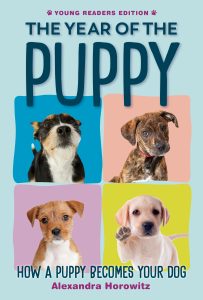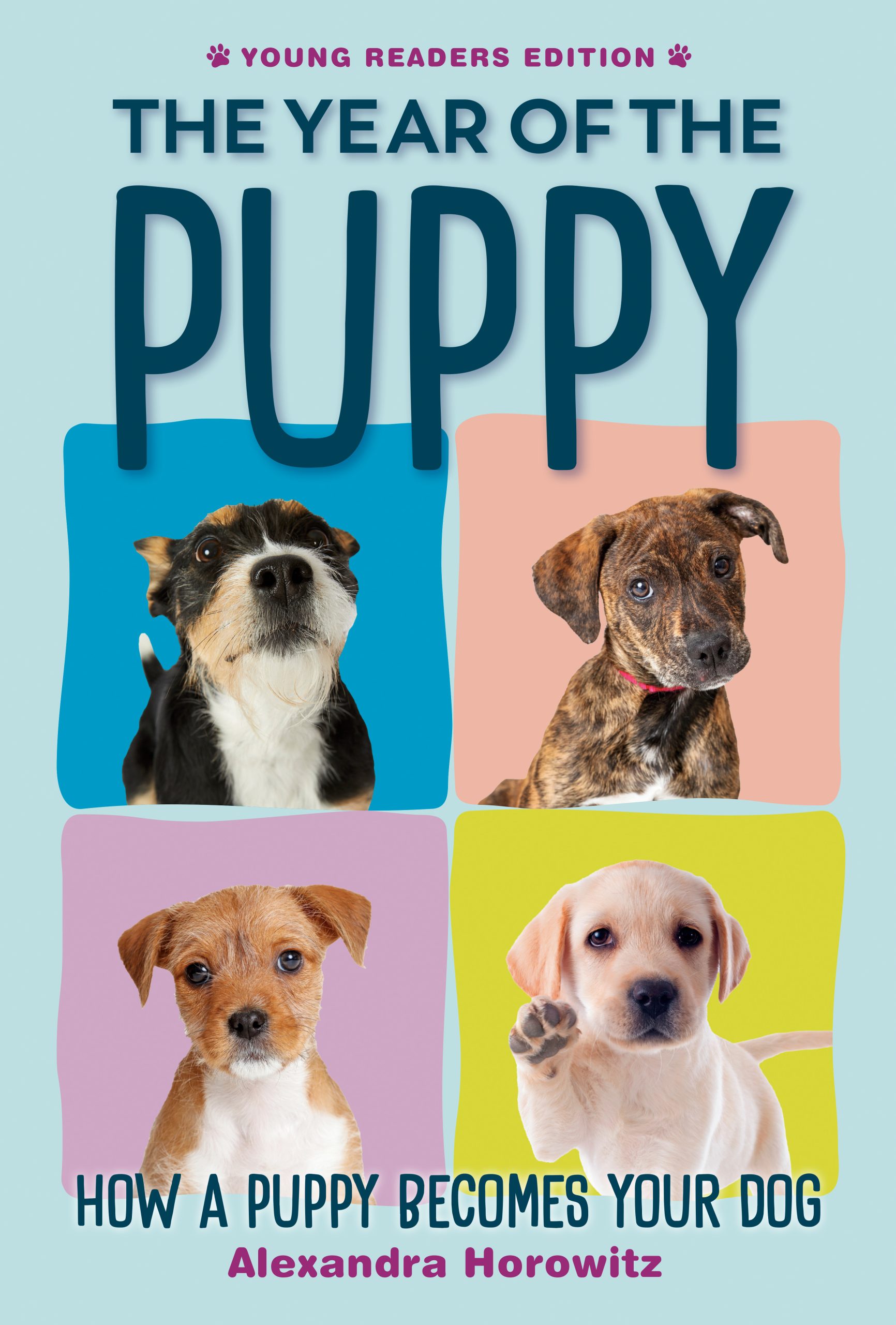Today we’re spotlighting THE YEAR OF THE PUPPY: HOW A PUPPY BECOMES YOUR DOG by Alexandra Horowitz!
Read on for more about the author, the book, plus enter the giveaway!
About the Author: Alexandra Horowitz

Alexandra Horowitz observes dogs for a living. Her research began more than two decades ago, studying dogs at play, and continues today at her Dog Cognition Lab at Barnard College. She is the author of Inside of a Dog: What Dogs See, Smell, and Know and three other books: On Looking; Being a Dog; and Our Dogs, Ourselves. She lives with her family of Homo sapiens, Canis familiaris, and Felis catus in New York City.
About the Book: THE YEAR OF THE PUPPY: HOW A PUPPY BECOMES YOUR DOG

What is it like to be a puppy? What’s going on in their minds? In this adaptation for young readers, Alexandra Horowitz answers those questions all kids have–and more!
Few people get to meet their dogs on the dog’s actual first birthday. Most of us missed the day our puppy opened her eyes, the first sweet sounds she made, or watching her learn to walk, bark, and play with her siblings. But the dog scientist Alexandra Horowitz got to. She met a litter of newborn pups, and traces their journey through their first year of life.
In this adaptation for young readers, follow along as one of the litter, Quiddity, grows from a sweet potato-sized puppy who can’t lift her head to a member of Horowitz’s family. Equal parts scientific and adventurous, Alexandra Horowitz’s delightful study of her own puppy’s developing personality is an enticing read that will answer every question a reader could have during a puppy’s first year.
~Excerpt~
Sweet Potatoes
I pull into the driveway of Amy’s home on a cold day. The sky is the kind of fathomless gray that makes you forget it could ever be blue.
I have come to see the puppies. As I knock, a commotion erupts inside—a chorus of barks, mixed with the sounds of dogs runing and scratching the door. A dog nose appears suddenly from behind a curtain, then just as quickly retreats. As the door opens, more dogs dart out: kelpies, wagging and barking and jumping up. Two older border collies saunter among them, calm schooners surrounded by crazed motorboats. There are eight dogs here, plus two more, I learn, that Amy is fostering, in another room. And then, too, the puppies.
Amy lets me in, and we step gently through the carpet of dogs. A radio is playing, an appliance hums; the smell of a birch fire greets me. One wall of the room is lined with shelves of trophies and ribbons from dog-competition events: agility, sheepherding, disc, mushing. Another wall has a giant cage in which a cockatoo who is missing her back feathers side-eyes me warily. “I’m bird sitting,” Amy explains, “and the people haven’t come back.” She gestures to another room, which has been given over completely to her own two parrots. At the same time, a calico cat saunters in and checks me out before sitting down to clean herself. Boxes of food and supplies donated for the fostered pups tower to the ceiling.
The new mom, Maize, is just visible outside the back of the house, staring intently at the screen door. I follow her gaze inside to the kitchen. I approach and navigate a baby gate, then climb over a makeshift wall segregating the kitchen appliances. Beyond that wall is a smaller pen, and within the pen is a small dog bed, and on one half of the bed is a pile of eleven puppies curled around one another. That pile is the object of Maize’s gaze.
Amy opens the door, and Maize runs in. Spotting a new person, she crouches submissively, and I also crouch and turn away to calm her. Amy places a large sausage of dog food on a plate for her, and she is calmed. We step into the pen and settle beside the dog bed. The pups, only several days old, are not quite dog- shaped yet; instead, they’re lumpish forms the eye registers as living but whose species one cannot quite place. They appear to be perfect sweet potatoes with ears, feet, and a tail. A white sweet potato adjusts herself and morphs into a piglet, short of snout and pink of body.
We scoot the bed onto a heating pad. The pile shifts. It is just above freezing outside, and the puppies will not be able to maintain their own body temperature until they are four weeks old. They lack the necessary extra fat for insulation, and they cannot shiver to warm themselves. Each pup’s body temperature is still several degrees below where it needs to be, and they instinctively keep one another’s close company. In the pile they form, they can get close to the 101.5-degree temperature that’s normal for adult dogs.
When Maize finishes eating she steps into the pen. Her smell steps in with her, the odor of milk and mom wafting over the pups. They stir as a heap, gently pulsing in her direction. Maize pokes her nose among the pups, licking and rousing them. She suffers my presence there with grace and even, guardedly, lets me pet her. Tiny heads lift, and mouths open, aimed mom-ward. At this age the puppies spend their lives mostly sleeping or nursing, and over the three hours that I am there, they do both, sometimes at once. The pups make soft squeaking, whimpering noises, shimmying over one another in the general direction of their mother’s belly. As they make their way over to Maize, she licks each one’s behind clean without comment. “She’s a good mom,” Amy says: patient, deliberate, and rump-cleaning.
When they fall off her belly, they collapse into the pancake-like posture typical of animals who cannot yet lift their heads for any length of time. After birth and their first meal, they weighed between just eight and thirteen ounces. Eight ounces is scanty: a simple cup of coffee. (Coincidentally, I have seen many a wee pup weighed by being put in a coffee cup set on a kitchen scale—a sight that is off-the-charts adorable.) Now, only a few days into life, some have doubled their weight, while others are struggling. The tiniest pup, whom Amy has named Chaya, with a head smaller than my fist, is half the size of Pawpaw, a merle puppy—his coat marked with patches of black, white, the gray called blue, and a copper called red, with moody dark makeup under each eye. I grasp Pawpaw and lift him toward me. He is heavy in my hand, but I can nearly circle his body when I close my fingers. Pawpaw squirms and utters a small gurgle, his paws outstretched, every toe reaching for ground. Each plump pad is an almost fluorescent pink, completely new out of the box. I set him down and grasp Chaya, then settle her between her siblings, where she has a chance at breakfast. A tan puppy with expressive eyebrows and a blaze of white, Pumpkin, coos at me, and I coo back to him as I stroke his soft back.
I gaze at them with astonishment. I feel let in on a secret, as a witness of this time in the lives of puppies. For now, it is not clear who is who; it is not clear that there is any who in there at all yet. In these early days of their puppyhood, eager to know them, we gather facts about their size and weight, comment on their colors, study whose ear is starting to stand upright. Later, when they begin showing distinct behaviors, we will note them all, collecting them like baseball cards—as though with each new fact or description, their true essence will be revealed to us.
We prod softly at the bodies to try to identify them all. Amy has named them for indigenous North American foods. Here are Fiddlehead, a blue merle with extra black markings, and three other merles, Calais Flint Corn (Flint), Blue Camas, and Persimmons, each with a distinguishing spot or fetching stripe of color. Underneath them we reveal Cholla Cactus, Acorn, and Cranberry, whose vary from gold to white as a sunbeam enters a high window and moves across their backs.
The final pup is not among the pile at Maize’s belly. Wild Ramps is a tricolor merle but mostly black, with a snout dipped in a white paint can and gold eyebrows. She is marooned on the puppy bed, the last one to whom it occurred either that Oh, the smell of mom is near or Oh, the warmth of siblings is missing, directing them toward mom. Her eyes, like those of all her siblings, are sealed closed in quiet protest at this bright world. Her ears, like those of all her siblings, are sealed closed in bright protest at this noisy world. She scooches herself on her belly, using the tools she has, pursuing warmth or smell, until she reaches the rim of the bed. Heading over the great wall, she topples dramatically, somersaulting and whimpering. Maize turns at her cries and licks her entire body in one long swipe, sending Wild Ramps onto her back. Righting herself, she heads straight for my knee, clothed in soft corduroy, and tests it for milk. I feel her tiny mouth puckered against it and am vividly aware of the inadequacy of my knee’s offerings. I pivot her lightly toward the rump of another puppy. Then she need only climb him, creep up the length of his body, and at last nuzzle her way in to the desired belly.

Title: THE YEAR OF THE PUPPY: HOW A PUPPY BECOMES YOUR DOG
Author: Alexandra Horowitz
Release Date: April 16, 2024
Publisher: Viking Books for Young Readers
ISBN-10: 0593351304
ISBN-13: 9780593351307
Genre: Hardcover Middle Grade Nonfiction
Age Range: 8-12
*GIVEAWAY DETAILS*






































The cover is adorable and the synopsis sounds fun.
aww i love seeing the different dog breeds on the cover and the book story sounds cute!